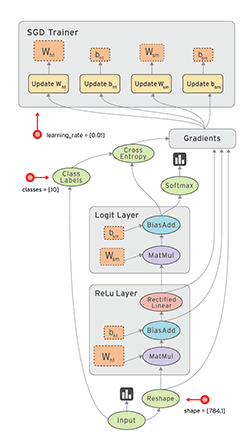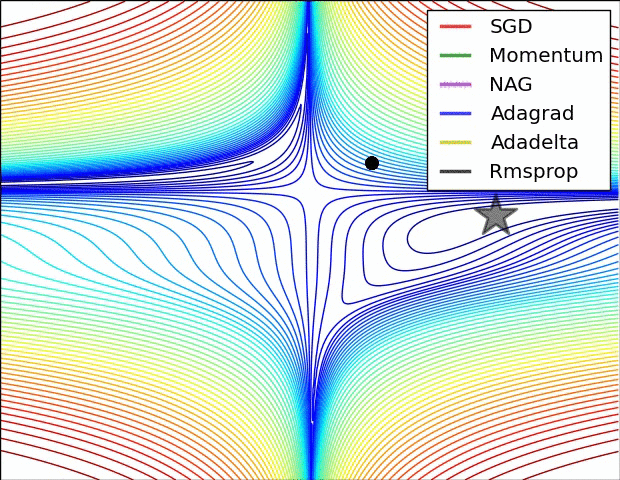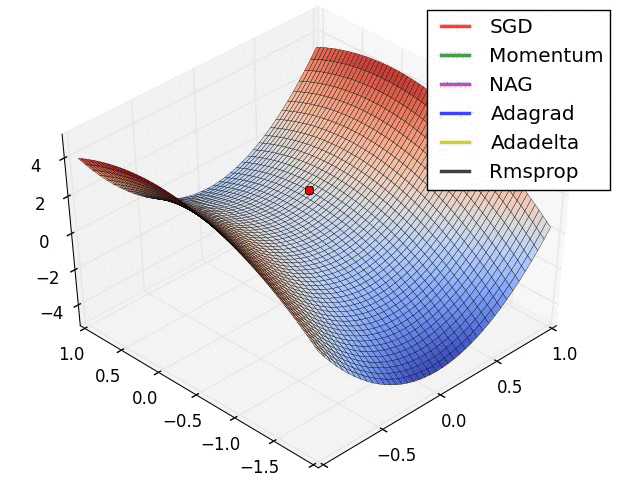Machine Learning
concrete content
2017 New New New TensorFlow CODE repository
Introduction Artifical Neural Network
[Optimization](https://en.wikipedia.org/wiki/Gradient_descent)
**Brief**: Input -> Process layer 1 2 3 ......-> Results
result provide feedback (reward)
Activation function
example(Training data) -> Training
final(testing data) -> testing
**Definition**: Artifical neural network(ANN) is a collection of connected artifician neurons, which inspired by Bio-neural network.
supervised or not: manualley labeld or not
**Method**: primarily focus on oprimization method
Gradient Descent
Cost function
obtaining Global minimum or local Minimum
a first order iterative optimization algorithm
asymptotic rate of convergence is inferior???Preparation(Tensor Flow):
Installation
'''
pip3 install --upgrade tensorflow
import tensorflow
'''
Input(example) -> Output(Results)
usage: prediction
overfitting line more
underfitting line
Basis Architecture
tensor flow basis
input -> hide layer -> output
1. input : dataset 1 2 3 4.......
2. hide layer: weights, biases, activation rules
3. output
4. Gradient Descent optimize metrics......
tensor flow basis coding
key idea of TF: error back-propagation algorithm through optimization method
optimization method this time: gradient descenttf Session
tf Variable
tf Placeholder
tf Activation Function
manual add layer
Basis TensorFlow
1. basis architectureFull Code
2. visualization
Full code
Speeding up training and Optimizer
1. stochastic Gradient Descent(SGD)
2. Momentum (using push)
3. AdaGrad (using rule to discpline)
4. RMSProp (basic rule + rule)
5. Adam (fully fule + rule)Tensorboard
inputs -> layer 1 2 3 4….. ->outputs
overview graph: as well as components graph:
Full code
Full code
Advanced Content
classification solution case
regression problem sovling -> output value
classification problem solving -> output possiblityactivation function:
regression using relu classification using softmaxcost function:
regression: real - prediction classification: cross_entropyoptimizer: both gradient descent
solving overfitting

For general situation rather than specific training data
states: underfit just_right overfit
Tensorflow solve: drop out
Full codeConvoltutional neural network(CNN)
Purpose: image text vedio (computer vision recognizationMethod: object Components.s.s -> combine -> combine ..->.->…. -> object classfied
pooling?
example: image->covolution->max pooling->connected -> classified
great resource
4. CNN buidling 1
code concept:image recognition, gradually compress hight and width in order to increase thickness (processing data in validation below ‘cp’)
CNN filtering quintessence
**Overview picture in example**:
image -> convolutionary -> pooling (cp)-> cp .......-> tensorflow(fully connected tf) -> tf -> classifer
key attribute in code: patch(compression related with padding) stride(step related pooling)
padding method: valid padding ; same padding
pooling method: max pooling ; average poolingCNN building 2
TensorFlow Libraries implment CNN
conv2a function
pooling module
padding module
key features: stride, patch, padding, pooling
Full codeCNN building 3
feeling: capture data -> reframe(reshape) data -> optimizer data
practical: padding, pooling, conv2d, adamoptimizer
Saver
purpose: store the trained parameter like(weights and biases)
issue: save parameters -> reload parameters
key: tf.train.saver
Recurrent Neural Network (RNN) 1
key: order matter issue solutions (sentence)common method: long term short term memory (LSTM)
collecting continum experience from previous experience(state) -> incfluence -> next experience (state)
using LSTM enable avoid
gradient vanishing and gradient explodingLSTM structure: Write(pre) - forget (mid) - read (after) ————three gates handle
Recurrent Neural Network (RNN) 2 Classification
RNN LSTMinputs hiden layer -> Cell -> outputs hiden layer
every cell has write forget read gates function
solving for gradient vanishing or gradient exploding 1. initial_states 2. c_state 3. m_state (basis only have this state)Tensorflow
‘’’tf.nn.dynamic_rnn()‘’’
difficulties: time_major, transpose
Noremal style or Tensorflow style
Extensive BPTT
Recurrent Neural Network (RNN) 3 Regression
data handling — batch
LSTM (input, cell, output)
Optimizer
‘’’
key attribute: input_size, output_size, cell_sizeinput layer
cell
Basic LSTM Cell
Lstm_cell.zero_state
tf.nn.dynamic_rnnoutput leyer
losses = tf.nn.seq2seq.sequence_loss_by_example()
‘’’
general difficulties:
datashape => reshape function
RNN key: Truncate Backpropagration Again:
Extensive BPTT
Recurrent Neural Network (RNN) 4 Visualization
plt_plot()
Autoencoder
Much like PCA
it is unsupervised learning
feel like trained compiler
encoder -> activation function
decoder -> activation functiontf.nn.sigmoid
difficulties: learning rate
Scope
corresponded with variable
‘’’
tf.name_scope
tf.variable_scopetf.get_variable() tf.Variable()‘’’
Understanding scope mechanism can reuse variable
especially in situation(RNN TrainConfig && TestConfig)
‘’’scope.reuse_variables()
- Batch Normalization (BN)
significance: if not, neurons lose efficacy, sensor capacity vanish
procedure:forwarding layer process BN after every time activation function
- Transfer Learning
(continum to learn when start again these bracket should be vanished)
current exsited model to operate
